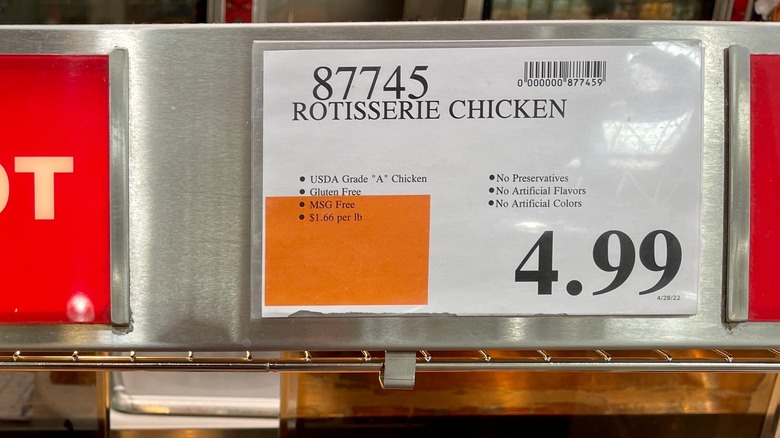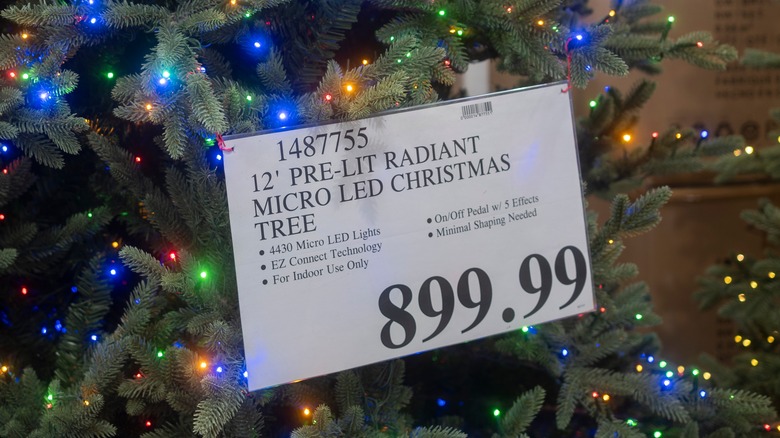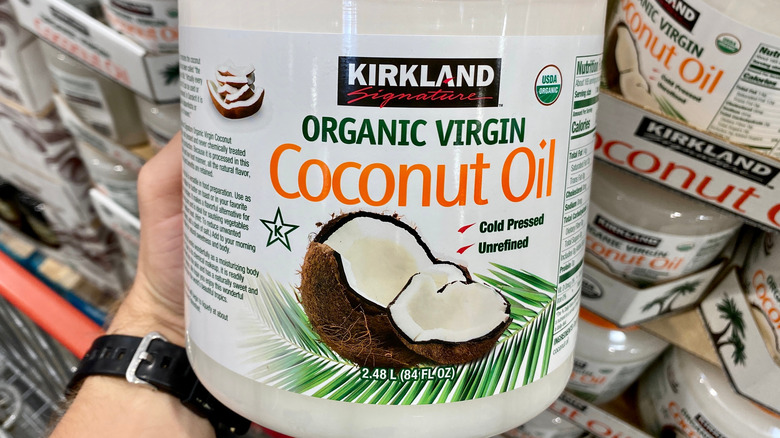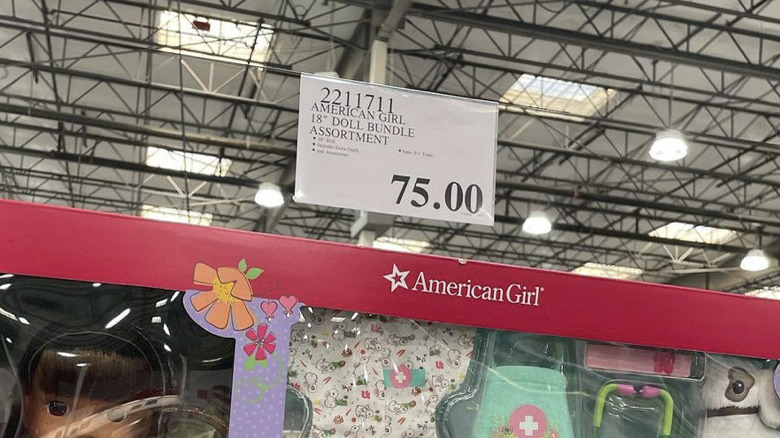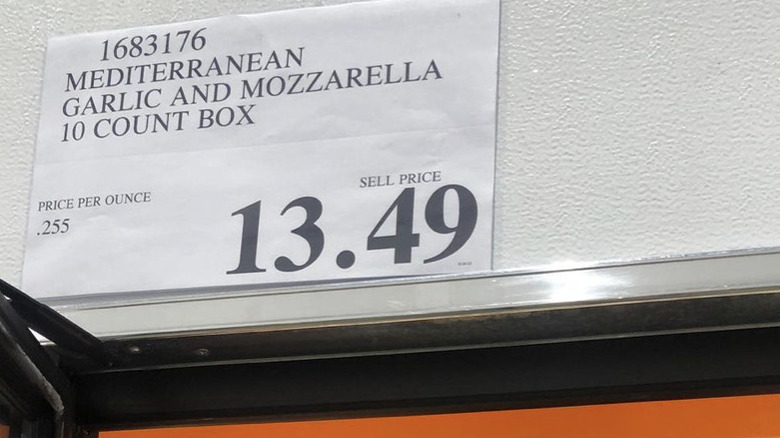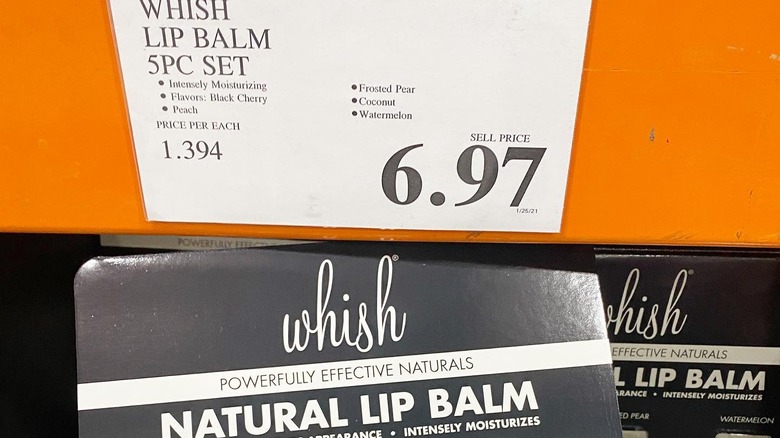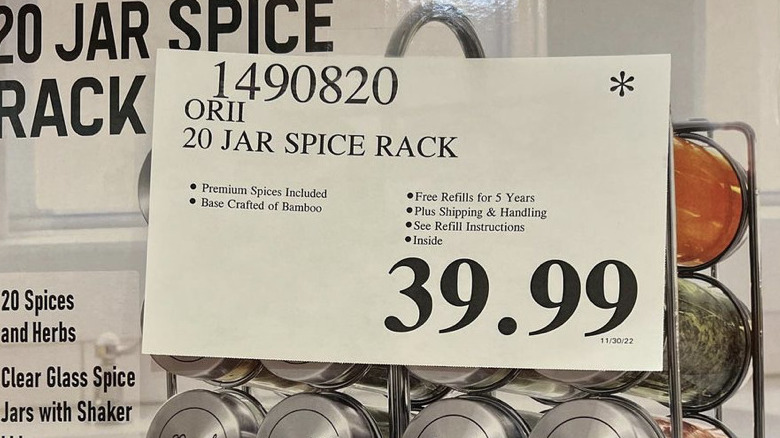6 Facts You Should Master About Costco's Price Tags
Each and every one of Costco's hundreds of warehouses stores are a massive operation unto themselves. Well-oiled and fast-moving machines, they rely on dozens of employees executing thoughtfully laid-out plans from an intricate infrastructure, ensuring that a community has enough of the bulk food and housewares they need. There are a lot of moving parts to a Costco, with thousands of products for sale at any given time, rising all the way up to the rafters of those cavernous stores. And every single one of them is priced perfectly, in terms of attractiveness to the average consumer, profit margin, and overall value.
All that information is embedded in the final, displayed selling price of an item at Costco, printed on a large, simple, black-type-on-white-paper sign. But look closely — there are a lot of numbers on a Costco price tag. They've all got meaning, too, reflecting and summarizing a lot of internal calculations that can tell a customer a lot about a product. Here's a decoder guide to what all those figures on a Costco price tag mean.
99 means business as usual
When a product hits the shelf at Costco, or it remains a top seller in its initially presented form for a while, it's likely to stay on the Costco shelves for a good long while, as long as it's a steady profit-generator. Part of the reason why a product may be irresistible to so many customers for an indefinite period of time is a price that can't be beat — a perceived great deal on a good thing (and a lot of it, too). A lot of thought goes into ensuring that the price listed on the black-and-white sign near it is as member-focused as possible, and Costco uses the age-old psychological technique (per Reader's Digest) of giving its regular-priced, regular products at cost to customers ending in "99," as in "$34.99." That essentially equates to $35, but costing just under that round number can trick the brain into thinking it's cheaper, making the purchase more likely. According to Best Products, standard Costco items are priced at numbers ending in "99" — even with embedded discounts and pricing procedures.
Organic foods get special billing
Like any major retailer that actively tries to evolve with the needs and wants of the marketplace in order to keep existing customers happy, and to attract new ones, Costco often brings in new products or newly available variations of existing things. For example, Costco has introduced many organic foods to its shelves, tables, bins, and freezers in recent years, to meet the increased and passionate demand for such meats, fruits, vegetables, and plant-based edibles produced without pesticides and under environmentally sound policies. An increasing number of members is purchasing these by the cartload. Whether a customer is eating organic on purpose, or they're looking to avoid such foods because they generally cost significantly more than their non-organic counterparts, Costco members benefit from some differentiation. At Costco, organic foods get a large price sheet like every other product, with the black legible print, except the paper is green, according to Reddit, universally recognized as the color associated with healthy and natural things.
Stranger pricing means buy it now while you can
More obscure or seemingly random price tag number endings act as a sort of secret code, both to Costco employees and those members who are in the know, and are well aware of what to look for. Pricing items at a number ending in "99" is so entrenched that seeing other numbers in the cents columns arouses attention, and it's a process that Costco seemingly reserves most for products that probably won't be around for very long, that it wants to move out quickly for a variety of reasons. According to Maui Family Magazine, if that price ends in either "88," or is rounded up to a full number ("00"), that means the stock on the item is low, or it's an item that was purchased already, returned, and the company can't sell it at its full retail price because of wear and tear or minor damage. Nevertheless, there's not a lot of that product left to buy, and it will probably disappear from Costco soon. An "88" or "00" thus means it's priced in such a way that it will soon be gone.
Price tags contain another secret symbol about a product's limited life on Costco shelves, according to Consumer Reports. If the sign includes a noticeable asterisk (*) in the upper right hand corner, that's a message that means the product won't be restocked, either due to the manufacturer discontinuing it or Costco declining to carry it any longer.
If the price ends in 49 or 79, it's a special promotion
One offshoot of the standard, tried-and-true "99"-ending pricing model is to finish off a price tag with a different "9" figure, like "49," "89," or "79," as in "$10.49," "$21.89," and "$49.79." The psychological effects of the "99" remain, but because the number is so out of the ordinary, it can catch a customer's eye and get them to pay attention. This has long been in practice at Costco, where an altered price tag on the occasional product amidst a sea of thousands can garner a closer look.
A "49," "89," or "79" on a Costco price tag indicates, very quietly and very subtly, a sale. According to Consumer Reports, these are limited-time prices reflecting a promotional offer arranged by the product's manufacturer or distributor with Costco brass. In other words, if you're looking to buy a product with a weird price tag, buy it now or soon, because it's not going to be such a bargain for long.
Seven is a lucky number at Costco
The hundreds of individual Costco warehouse-style club stores largely take their cues on pricing from the corporate office — it's somebody's job at headquarters to precisely price all of the chain's many products. But they aren't beholden only to their bosses, or tasked with executing a manufacturer-ordered temporary discount — a manager of any Costco store has the power to occasionally (and relatively rarely) lower prices on some items. These are unofficially known as "manager specials," and they can be spotted with a very subtle indicator on Costco's no-frills price signs. If the printed and displayed price ends in a "97," versus, say, the usual, go-to "99," that means the item in question is on manager special, according to Money Genius. How much of a discount? Well, it's at least more than the obvious two cents markdown. Since the local Costco managerial department set the price, customers could feasibly track them down and find out how much of a discount they're embracing.
Costco price tags count the days
Like a microcosm of the vast and abundant Costco store, a Costco price tag overflows with stimuli and information — there's just a lot of information on that little sheet of standard-size printer paper with some black ink in a legible font on there. There's a product ID number up top, the name of the product, the size or count, the sell price, a unit price, and a UPC code. There's one more figure on there, too, one that's a little harder to see via a quick glance 10 feet away from the shopping floor. Right there, under the huge sell price is a six-digit number, broken down into three sections with two forward-slash characters. It looks like a date, because it is a date. That's not an expiration or sell-by date on the product itself, but rather a Costco-issued, internal reference regarding that close-by sell price. That date, which is always going to be in the past (if it's not the current day), indicates the last time that the price of the item was changed or established. If that date is several months old, it could mean that the product is due for a change, becoming more expensive or less expensive. But if that date change is there along with an asterisk on the price, there's a very good chance the item will soon see a cost reduction of some kind, according to Money Genius.
